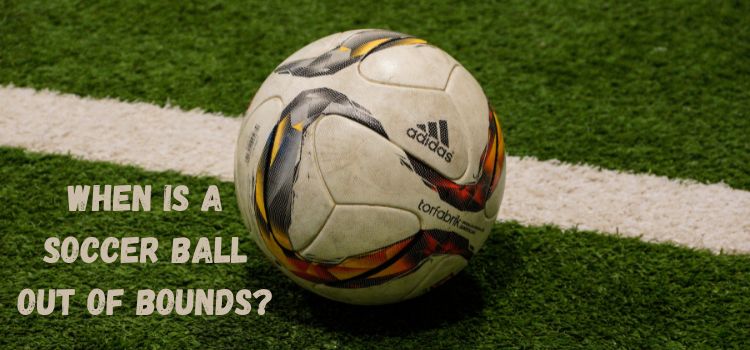As an Amazon Associate, I earn from qualifying purchases
Here’s what we have to say about the intriguing question that echoes across soccer fields worldwide: “When is a Soccer Ball Out of Bounds?” As passionate enthusiasts of the beautiful game, we understand the importance of unravelling the mysteries that unfold during a match.
In this insightful exploration, we will delve into the intricacies of determining when a soccer ball is officially out of bounds, shedding light on the rules that govern this pivotal aspect of the sport.
Join us on this journey as we break down the scenarios, rules, and nuances surrounding the out-of-bounds phenomenon in soccer. Whether you’re a seasoned player, a devoted fan, or a curious observer, this guide aims to clarify and deepen your understanding of the game we all love.
Stay with us as we navigate the sidelines and touchlines to unravel the secrets of when a soccer ball is truly out of bounds. Let’s kick off this exploration together!

Introduction:
The rules and regulations of soccer, often called the “beautiful game,” add to its unique charm. One fundamental aspect that players and spectators must grasp is understanding when a soccer ball is out of bounds. This seemingly simple concept has profound implications for the flow and outcome of the game.
Basic Rules of Soccer:
Before delving into the intricacies of out-of-bounds scenarios, let’s briefly revisit the basic rules of soccer. The game is played on a rectangular field, and the objective is to score goals by getting the ball into the opponent’s net. Game dynamics, however, are heavily influenced by the field’s boundaries.
Definition of “Out of Bounds” in Soccer:
In soccer, a ball is considered out of bounds when it completely crosses the perimeter lines of the field. This decision is typically made by the match officials, primarily the referee. This definition is vital for players and fans to comprehend the stoppages and restarts during a match.
Boundary Markings on the Field:
To determine if the ball is out of bounds, one must be familiar with the boundary markings on the soccer field. The touchlines run along the field’s length, while the goal lines span the width. These lines serve as visual indicators for referees to make accurate decisions.
Throw-ins:
The throw-in is a common situation associated with the ball going out of bounds. The opposing team is awarded a throw-in when the ball crosses the touchline. Players must use both hands and deliver the ball from behind their head, ensuring it re-enters play.
Goal Kicks and Corner Kicks:
Goal and corner kicks are other instances tied to the ball going out of bounds. An attacking team’s ball crosses the goal line after being touched by the defending team, resulting in a goal kick. On the other hand, a corner kick is given to the attacking team when the ball crosses the goal line after a defender touches it.
VAR (Video Assistant Referee) and Out of Bounds Decisions:
A video assistant referee (VAR) has significantly changed out-of-bounds decisions in recent years. VAR allows officials to review contentious situations and ensure accuracy in crucial game moments.
Common Misconceptions:
Despite the precise rules, there are common misconceptions about out-of-bounds situations. Some may argue that a portion of the ball needs to be visible outside the line, while in reality, any part of the ball crossing the line qualifies as out of bounds.
Strategies to Stay In-Bounds:
Players, especially wingers and full-backs, must develop strategies to keep the ball in play. Training methods focusing on ball control, footwork, and spatial awareness can significantly reduce the frequency of out-of-bounds situations.
Historical Moments: Famous Out-of-Bounds Goals:
Soccer history is adorned with moments where players showcased exceptional skill by scoring goals from seemingly impossible positions, including situations where the ball appeared to be going out of bounds. These moments not only captivate audiences but also highlight the unpredictable nature of the game.
Technology in Soccer: Tracking the Ball:
Modern technology has brought about advancements in tracking the ball’s position on the field. High-tech cameras and sensors contribute to precise measurements, aiding referees’ inaccurate judgments regarding out-of-bounds situations.
The Evolution of Out-of-Bounds Rules:
Over the years, soccer’s governing bodies have refined and adapted rules related to out-of-bounds scenarios. These changes aim to enhance the fairness and fluidity of the game, acknowledging the evolving nature of sports.
Out-of-Bounds Challenges in Different Playing Surfaces:
The condition of the playing surface adds an extra layer of complexity to out-of-bounds decisions. Wet or uneven fields pose challenges for players and officials, requiring adaptability to different weather conditions.
Importance of Fair Play:
Respecting boundaries is not just a matter of rules; it reflects sportsmanship and fair play. When players embrace the spirit of the game, everyone involved has a positive and enjoyable soccer experience.
Conclusion
In conclusion, when a soccer ball is out of bounds, it is a fundamental aspect of the game. From the basic rules to the evolution of technology influencing decisions, understanding these dynamics enhances the overall soccer experience. Players and fans should embrace the nuances, appreciating the beauty of the game’s unpredictability.
Frequently Asked Questions (FAQs)
Players who are out of bounds cannot touch the ball.
The game continues if the ball re-enters the field after going out of bounds without any infringement.
No, the corner flag is part of the field, and the ball is still in play if it touches the flag.
VAR is typically used for significant decisions, and not every out-of-bounds situation is subject to review.
While the basic concept remains the same, some age groups may have slight variations in rules based on the governing bodies overseeing their competitions.
Read Our More Articles
- What Is a Club Soccer Ball: Unveiling the Essence
- What is a Pitch Soccer Ball? Unveiling the Essence of the Game
- What is the Best Soccer Ball in the World? Get the Answer Here!
As an Amazon Associate, I earn from qualifying purchases


